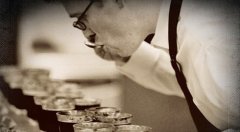Barista training knowledge-Coffee History

In 1000 there was a doctor in Bukhara, and the philosopher was the first to record the therapeutic effects of coffee.
The application of 1470-1500 coffee spread to Mecca and Masterna.
1517 brought coffee to Constantinople after conquering Egypt.
The first coffee shop in Costantinople opened in 1554.
1570-80 religious institutions in Costantinople ordered all coffee shops to close.
1600 Muslim Baba Budan brings coffee to western India.
1616 coffee is brought to the Netherlands from Mocha.
The first coffee shop in Venice, Italy, opened in 1645.
The first coffee shop in Oxford, England opened in 1650.
1658 Dutch began to grow coffee in Ceylon.
1668 coffee was brought to North America.
1669 the Turkish ambassador introduced coffee to France.
1670 coffee was brought to Germany.
1674 British women collectively oppose coffee.
In 1675, King Charles II ordered all coffee shops in London to close, claiming that they had gathered reactionaries.
The first coffee shop in Germany opened in Hamburg in 1679.
The first coffee shop in Paris opened in 1689.
The King's Arms, the first coffee shop in the United States, opened in New York in 1696.
1706 coffee trees planted in Java, Indonesia were taken back to the Dutch Botanical Garden.
1714 the Netherlands cultivated saplings from Java into trees and gave them to the then King of France, Louis XIV.
1720 Caffe Florian, which is still in business, opens in Florence, Italy.
1723 Gabriel de Clieu brought coffee seedlings from France to Matinique.
1727 Francisco de Mello Palheta brought coffee seedlings from France to Brazil.
1730 Britons bring coffee to Jamaica.
1732 musician Bach composed "Coffee Music" ("The Coffee Cantata"), pushing the coffee craze in Germany to a new high.
1777 German Emperor Frederick the Great belittled coffee and promoted beer as a German national drink.
1809 Brazil exported coffee to the United States for the first time and landed at Port Salem, Massachusetts.
1869 Coffee leaf rust was first discovered in Ceylon and nearly wiped out coffee trees in India, Ceylon and much of Asia in the following 10 years.
1873 John Arbuckle launched its first coffee powder brand "Ariosa" in the United States.
The New York Coffee Exchange opened in 1882.
1904 Fernando Illy invents the first modern Expresso coffee machine.
1906 Brazil retains some of its coffee harvest to raise international coffee prices, which the international market calls the "Coffee heroic Initiative" (Valorization of Coffee).
1910 German company Merck Co. Introduce decaffeinated coffee (Dekafa) to the United States for the first time.
1911 the American coffee roasting industry forms the National Coffee Association.
1928 the Columbia Coffee Federation of South America.
1944 Brazil destroys 78 million bags of coffee.
1938 Nestl é technicians invented instant coffee in a Brazilian factory for the first time.
From 1939 to 1945, the United States Army brought instant coffee to the world.
The face of 1959 Juan Valdez has become a trademark of Colombia.
In 1962, the United States became the country with the highest average annual consumption in the world, reaching 3 cups per person per day.
1962 the International Coffee Agreement was established to represent the global coffee producers.
1971 Starbucks opened its first store in Seattle, USA.
1973 the first batch of Fairtrade Coffee was shipped from Guatemala to Europe.
In 1975, coffee production in Brazil has been greatly reduced due to snow freezing, and the price has soared.
1985 the International Coffee Agreement disintegrated and the price of coffee fell sharply.
1990-1995 Specialty coffee became popular.
1995 organic coffee became the protagonist of Specialty coffee.
Starbucks opened 2000 stores in 1998.
Important Notice :
前街咖啡 FrontStreet Coffee has moved to new addredd:
FrontStreet Coffee Address: 315,Donghua East Road,GuangZhou
Tel:020 38364473
- Prev

Analysis of acid components in coffee the acidity of washed beans is higher than that of sun-dried beans.
The acidity of coffee is usually considered to be related to the quality of coffee. Acidity is typical of high-value coffee in Central America and East Africa. Excessive sour taste is considered to be the disadvantage of coffee. Acidity is related to growing at very high altitudes and mineral-rich volcanic soils. The acidity of washed beans is higher than that of sun-dried beans. For example, the concentration of sun-dried beans is heavier than that of washed beans, because the concentration obscures the acid of coffee.
- Next

The Primary processing of Coffee beans Coffee Bean treatment
Washing is the most popular and widely used method of raw bean treatment at present, and most of the boutique coffee beans will choose the washing method. In South America, all countries except Brazil choose to wash raw beans. Washing is the most scientific and technological method among all the treatment methods, and multiple screening is used to ensure the uniformity and stability of coffee bean quality. First of all, still
Related
- What is the meaning of lactic acid fermentation with coffee bean treatment?
- How to judge the state of foam by sound?
- How does the latte pull out the unicorn pattern? Come to get for a little trick to improve the flower pull!
- Will flower pulling affect the taste of the latte?
- Do you know the history of coffee?
- The difference between honey treatment and sun washing what is raisin honey treatment?
- What kind of milk can a novice use to make coffee foam to keep the foam longer? The correct method and skills of milking tutorial sharing
- Why do washed coffee beans taste sour? Flavor characteristics of washed Coffee
- Introduction to the skill of how to practice the size and height of water injection around the circle of hand-brewed coffee
- How do beginners practice coffee flower drawing from scratch?

